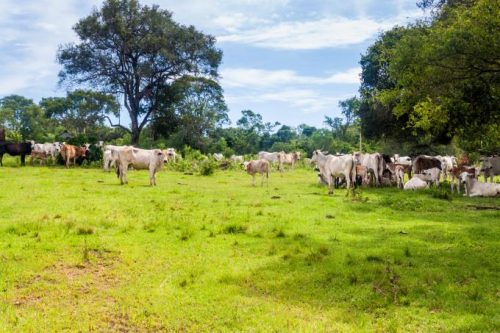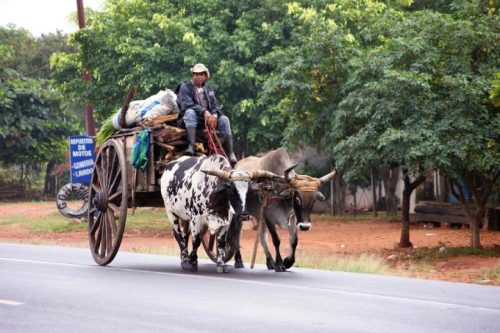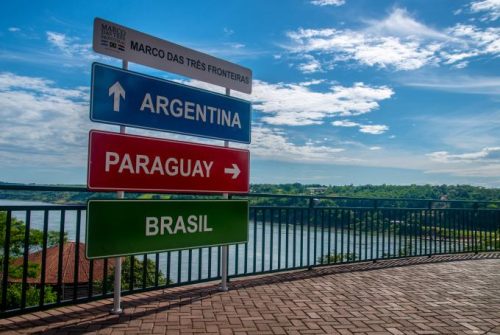An economy controlled by a few.

Paraguay is a country with a strong rural vocation where the agri-food sector predominates, firmly in the hands of the landed oligarchies active in the production of soya, mostly transgenic, wheat, and rice.
These crops also constitute the majority of exported goods, together with hydroelectric energy of which the country is the world’s leading exporter thanks to the production of the two large binational hydroelectric power plants: Itaipu (Paraguay and Brazil) and Yacyretà (Paraguay-Argentina), and that of further plants, certainly of smaller size, located within the national territory.
Paraguay also produces sugar cane, used mainly for the manufacture of rum and alcohol, tobacco, and cotton. In the few plots of land owned by farmers and small landowners, subsistence agriculture has developed, producing corn, cassava, beans, and fruit. The predominance of the agricultural sector, both industrial and subsistence, must, however, deal with the climate factor whose effects make crops vulnerable and, consequently, the economy of the entire country. Also of great importance is the livestock sector, which is gaining importance in the international meat market, and in particular, the extensive beef sector, which is dominant in the central regions of the Chaco and is among the main causes of deforestation in this area.

Herd of cows near Coronel Bogado town. About 85% of the land, around 30 million hectares, is owned by just 2% of the agrarian oligarchy.123rf
In addition to agriculture, trade and services also offer good support to the country’s economy which, unfortunately, is characterized by significant territorial heterogeneity in which the departments of Asunción, Alto Paraná, Central and Presidente Hayes are remarkable for their vivacity. The major national industries linked to the food sector are concentrated in Asunción and Central – sugar factories, meat processing and preservation industries and the production of alcoholic beverages – electromechanical chemical industries, cotton textiles, tobacco, wood, leather, glass, and concrete.
Last year the country stood out, compared to the countries in the area, for its economic performance whose growth is around 4.5%, reversing the trend of 2022 which reached only 0.2% due to climatic factors that have had a strong impact on the agricultural sector. This year’s positive performance, however, is unlikely to produce benefits for the entire population which experiences high levels of poverty dictated by the unequal redistribution of resources. We must bear in mind that 85% of the land, around 30 million hectares, is owned by just 2% of the agrarian oligarchy, the Human Development Index, calculated by the United Nations, places the country 105th in the global ranking, while 40% of the population live below the poverty line. In rural areas, 41.2% of the population does not have a monthly income to cover basic needs, while in urban centres this percentage is 27.6%.

In rural areas, 41.2% of the population does not have a monthly income to cover basic needs. Photo: Pixabay
For many poor people, the river constitutes a thriving economic resource, enabling them to irrigate their fields and engage in fishing. They sell their fish and agricultural products in the local markets.
This has, however, generated problems in large cities such as Asunción where farmers who have fallen into poverty have moved along the banks of the river in search of an easier life, even if they are periodically
forced to deal with the floods that oblige them to move to temporary accommodation.Paraguay is among the founding countries
of Mercosur and the WTO.
At the regional level, Brazil and Argentina constitute the major economic partners. Furthermore, the country has also signed trade agreements with Colombia, Egypt, Israel, Peru, Bolivia, Chile, Morocco, Mexico, and India. Profitable trade relations are maintained with the United States, the Russian Federation, Singapore, and China. Regarding China, it is worth highlighting that in recent years, following the pandemic and swine fever which also spread to the Asian continent, Paraguayan soy and meat producers have exerted strong pressure on the country’s governments, aimed at facilitating exports towards the Chinese market. This pressure, however, has not had the desired effects due to the strong diplomatic ties that exist with Taiwan which, if called into question, would alter regional geopolitical structures.

The Triple Frontier, a tri-border area between Paraguay, Argentina and Brazil. Shutterstock/ lu_sea
The expansion of the country’s trade and industrial development are also strongly conditioned by infrastructure and telecommunications deficiencies, despite the geographical centrality of the country and the connection with the river system, known as Hidrovia and of which the Paraná is also a part, on which ports of international importance such as that of Rosario are located on the coasts. However, this system is heavily exploited by criminal organizations for their illicit trafficking which benefits from the poor security conditions and the absence of controls, also by a Mercosur regulation which, to facilitate navigation on the channels, provides for the prohibition of carrying out checks on goods in transit. This led to the signing of a memorandum with Washington which allowed the landing of US military personnel, whose presence should guarantee ‘better navigability conditions’ in the stretch of river that crosses Paraguay, as well as combatting drug trafficking, in particular cannabis, of which the country is the main producer in the area. Cocaine also travels via river from Bolivia and Peru and has an important logistical hub in Paraguay, as demonstrated by the huge drug seizures made in Europe, managed by massive criminal structures. From there, the drugs are directed towards Montevideo where the Hidrovia ends, thus entering into connection with the Atlantic ports. The porosity of the Triple Frontera, defined as a strategic hub for criminal and terrorist groups from across the continent, becomes crucial for the development of this business whose value is said to amount to 43 billion dollars a year. It is worth pointing out that some analysts warn against excessive emphasis on the criminal and terrorist phenomenon present in the Triple. It will be functional, in their opinion, to create the conditions for greater penetration by Washington in the area, to exploit the natural water resources (which the USA lacks) of the Guarani basin and, at the same time, keeping Brazil and Argentina under strict control. (Open Photo: Asunción waterfront. CC BY-SA 4.0/ Overkill53)
Filippo Romeo



